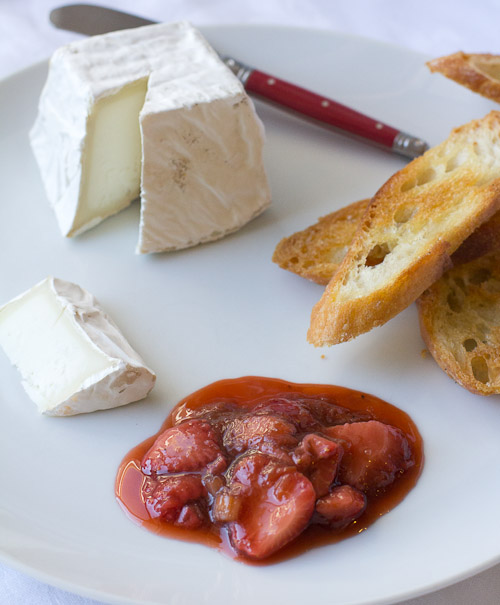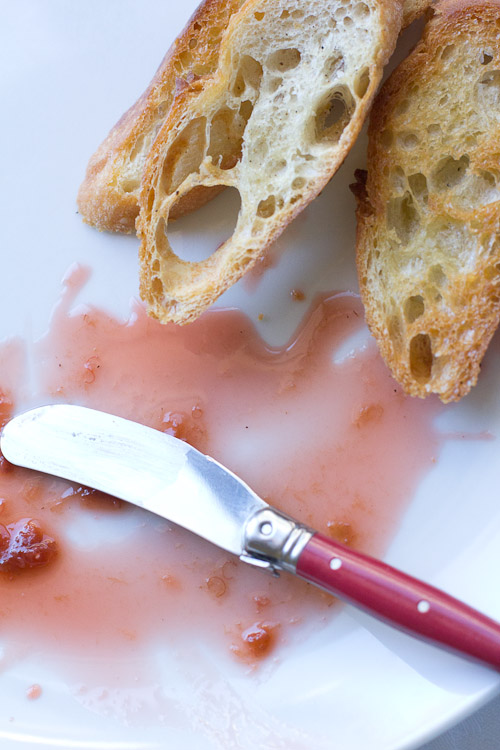Strawberry-rhubarb balsamic compote for spring goat cheese
Springtime in CheeseVille means baby lambs, goat kids, clover in the fields, and… the return of delicious, small production goat and sheep's milk cheeses to the tables of dairy lovers everywhere. Party. Time. As is easy to forget when gallons of cow's milk are lined up 20, 30 in a row on dairy shelves at grocery stores, milk is a seasonal thing. American cows for the most part have been bred so they breed year round so we have that half-and-half for our coffee in the morning, every morning, but that's not always the case with goats and sheep.
In fact, if goats and sheep are completely in tune with the natural seasons, with when the sun rises and sets, with the changing leaves, they get a little frisky during the fall and winter. They can be cooped up in barn, get a little closer with their neighboors, it's understandable. This means they'll start having their babies around spring. If a creamery is completely in tune with the animal's natural birthing and lactating tendencies, that also means that they might be waiting to milk into now, too; at some farms, animals get a break during off-seasons. But now, when the mamas are birthing, there is milk aplenty. Fresh goat and sheep cheese fever! That's the first part of the story. The second part is that after dairy animals give birth, their milk is at its most nutritious, and very rich. This is good for us too.
Then there is the third part of the spring cheese story. Remember those clovers I mentioned in the first sentence? Well, the Sonoma and Marin hills are full of them, and a lot more. I'm thinking its similar at a farm near you. Think wildflowers just starting to bloom, and mustard and wild herbs. When the goats and sheep, who love prancing about and getting in the nooks and crannies of the fields (or just beyond the field, those rascals) eat the wild spring and summer vegetation, the flavors come through in the milk. If you've tasted a goat cheese in spring or summer and thought it tastes more herbal or vibrant then a wedge of the same cheese you had in winter, you were probably right. Those animals had been snacking.
To celebrate this season of cheeses, I created a recipe to highlight the flavors in the fields, made for goat cheese. But it would work equally well with young sheep's milk cheeses too. The cheese I created the recipe for is Pug's Leap Pavé, above. Pug's Leap is a much-loved Petaluma creamery that went out of commission for a while while transitioning to different ownership. Well, as of a couple months ago, it's back, and producing bloomy-rinded styles that are lively, thick and flaky, and slice-ready for being put on a crostini with strawberry-rhubarb balsamic compote.
With their crimson colors and green flare, strawberries and rhubarb were catching my eye at the market. Normally it's just about the start of fall when I think, I should really do something with rhubarb, except by then, it becomes I "should have really done" something with rhubarb. Not this year. To the compote I added balsamic vinegar. Its acidic and dark sweet tones bring out the citrusy flavors in the seasonal cheese. Then, inspired by Chef Courtney Burns's recipes from an article I wrote for Culture, I added a bit of freshly ground pepper. When I converted Burns's Bar Tartine dessert recipes from restaurant-ready to home cook-friendly for the article, I loved that she incorporated savory notes into her desserts. The black pepper was my nod to her and pairs with any herbal, peppery goat cheese notes. This compote's flavors is made though, to honor the goat. Or the sheep. It's also quick to make, produces about a 1 1/2 cups of compote, and the leftovers are pretty major on steel cut oats in the morning.
Ingredients
1/2 pound rhubarb- sliced half an inch thick
1/4 cup plus 1 tablespoon granulated white sugar
1 tablespoon honey
1/8 tablespoon freshly ground pepper
3 tablespoons balsamic vinegar
2 cups sliced strawberries- sliced a quarter inch thick.
In a medium saucepan, combine the rhubarb, sugar, pepper, honey, and balsamic and stir with a wooden spoon. On high heat, warm until the balsamic starts bubbling. Once bubbly, reduce heat to medium-low. Cover the pot with a lid, leaving it slightly ajar so steam can escape. Cook for seven minutes, lifting lid to stir occasionally. Take off the lid and cook for two more minutes, or until half of the rhubarb in the pan is soft and dissolving, like in the fifth photo above. Add the strawberries to the pot and stir. Continue cooking on medium-high heat for ten to fifteen more minutes, until the strawberries start to soften, but still keep their shape.
What are your favorite things to eat or drink with your seasonal goat and sheep's milk cheeses?








